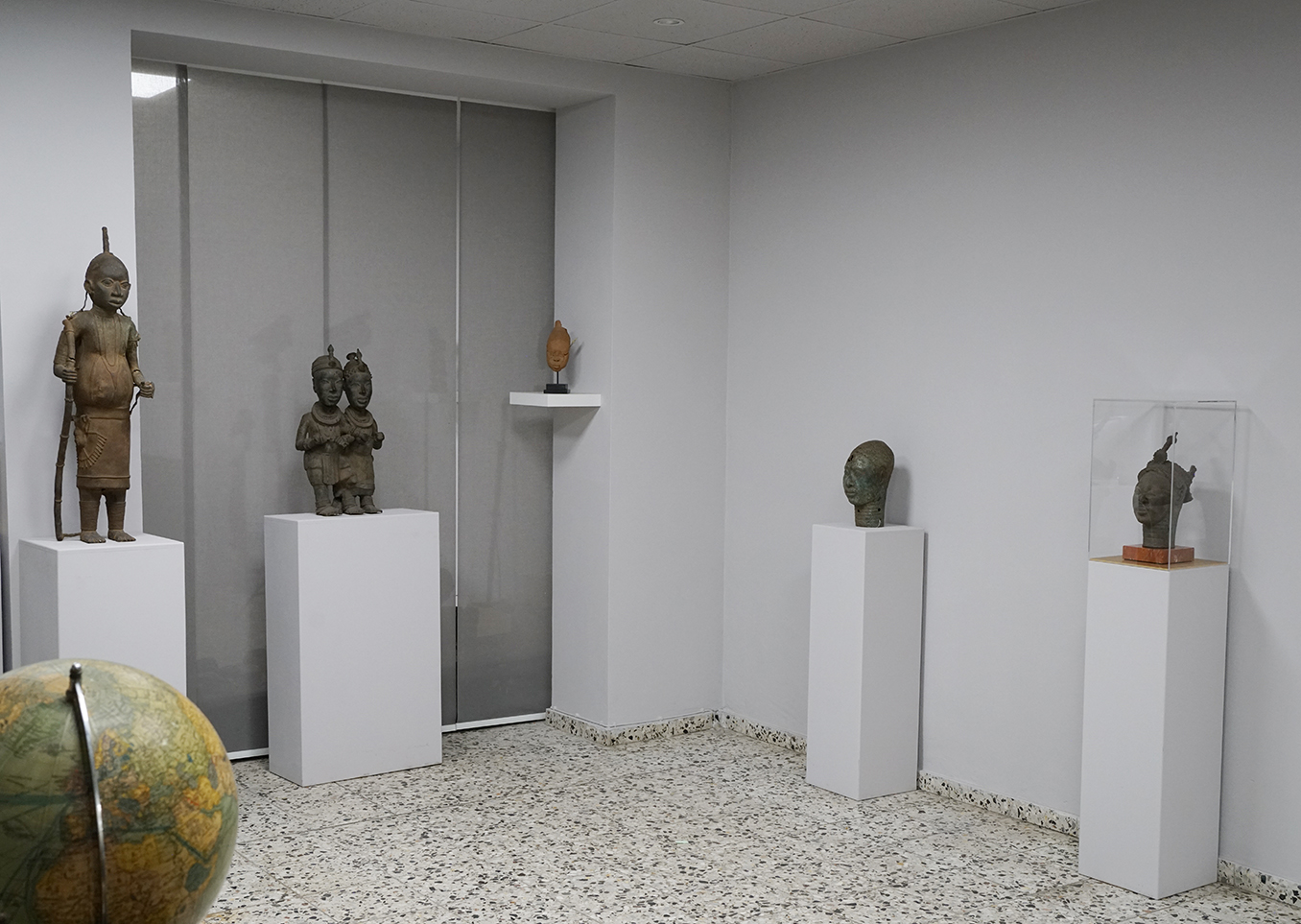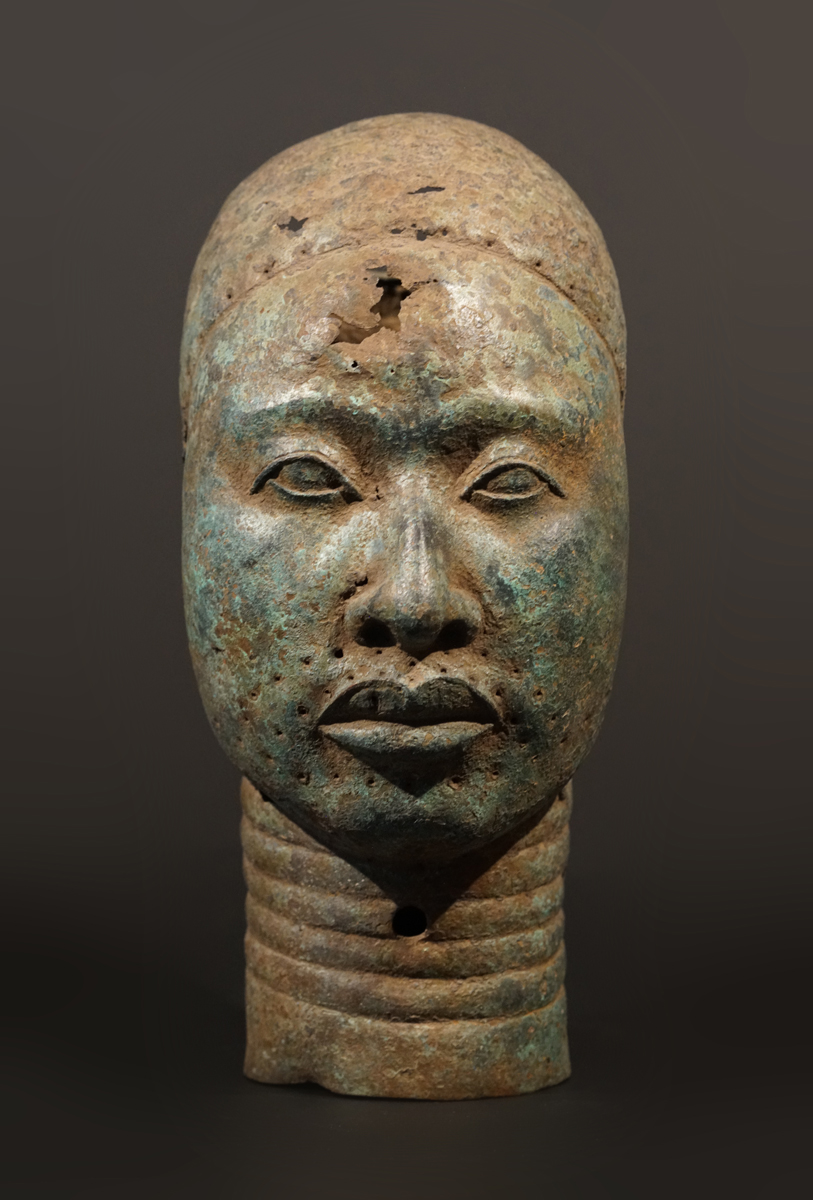 |
 An Ife bronze head, which maybe represents the usupartor Lajuwa, who took possession of the throne of Ife after the death of Ooni Aworokolokin or it is an unknown young Oba; produced in the lost wax casting method with very fine thin walls, partly greenish encrusted patina.
The portrait is of a relative youthful man. It is calm and dignified with the mouth shut. It is particularly engaging - in quality and appearance, and with deep serenity. Art-historical importance of this piece lies in its highly developed and distinctive sculptural style, in the tension between realism and abstraction. On one side it is naturalistic, portrait-like and on the other side it´s classical and timeless. It is an idealized naturalism. The work is characterized by the typical Ife style features: The corners of the upper eyelids hang over those of the lower ones. Around the lips is an accented edge. There are grooves around the neck.
Literature:
Bronzes and Terra-Cottas from Ile-Ife, H. Meyerowitz and V. Meyerowitz, The Burlington Magazine for Connoisseurs,. 75, No. 439 (Oct., 1939), pp. 150-152+154-155. Arts de L'Afrique Noire, Jean Laude, translated by Jean Decock, University of California Press Berkeley, 1966, 1. Paperback-Edition 1973, p.118. 2000 ans d’histoire africaine. Le sol, la parole et l’écrit. Mélanges en hommage à Raymond Mauny. Tome I. Paris : Société française d'histoire d'outre-mer. Ife and Raymond Mauny, by Thurstan Shaw, 1981, 5-6-1, pp. 109-135. Nigerian Bronzes: work from Ife, K. C. Murray, Vol. 15, Issue 57, March 1941 , pp. 71-80.
According to the UNESCO Convention of 1970, a claim for repatriation expires one year after the authorities of a country of origin have learned where and with whom a cultural object is located. Wolfgang Jaenicke Gallery therefore always informs about every newly imported object. Especially about the bronzes from Nigeria shown on this page, which are published in the internet and are accessible to everyone. Organizations dealing with restitution issues, but also freelance art historians employed by the state, such as restitution experts like Bénédicte Savoy, are regularly informed about objects in the Galerie Wolfgang Jaenicke.
Every buyer of an art object, regardless whether it is made of wood, terra-cotta or bronze, must be aware that from a European legal perspective, traditional African art usually came from the respective African country of origin with insufficient export documents. Galerie Wolfgang Jaenicke, Berlin, tries to do justice to this dilemma by acting with the greatest possible transparency. The export policy of African states is problematic for art historical research, since African and European dealers usually work covertly due to diffuse legal situations and important information that was passed on from trade to science before 1970 tends to be lost.
In case of uncertainties, please contact the managing director of Jaenicke-Njoya GmbH, Wolfgang Jaenicke. It is in the interest of the gallery to clarify any questionable situation with all available means.
TL Analysis Kotalla 400 years +/- 18 percent
more info on request
Height: 31 cm
Weight: 1,9 kg

Ife - Benin Exhibition, July/August 2019, Wolfgang Jaenicke Gallery, Berlin
|
 photo: wolfgang-jaenicke.com, for more information, please write us an e-mail with the identification number of the photo identification no. GSC06863.jpg
photo: wolfgang-jaenicke.com, for more information, please write us an e-mail with the identification number of the photo identification no. GSC06863.jpg |
|

